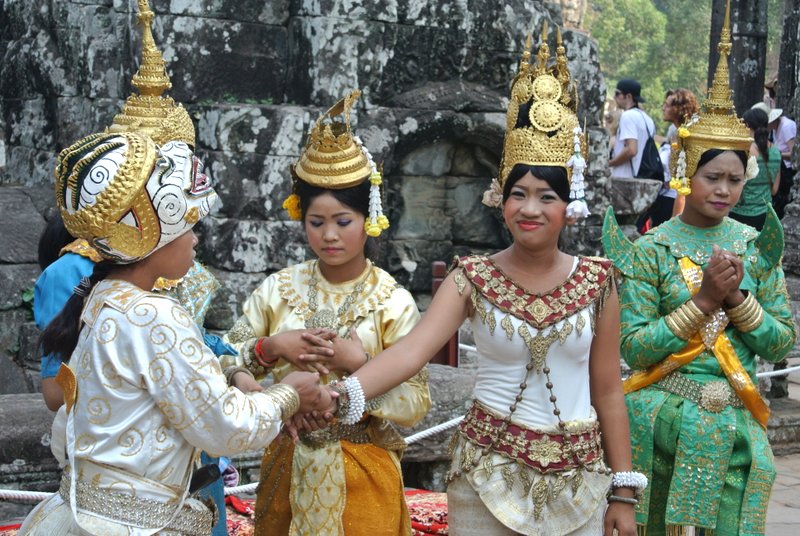Angkor Wat, a UNESCO World Heritage Site, is only a short distance from the modern (meaning it has an airport) city of Siem Reap, Cambodia. It is the major tourist attraction in the country. During our stay, we saw more Anglo faces than we had since the wheels came up and we left Atlanta. It is truly a world famous tourist site. There were Americans, Brits, Australians, Russians, and Europeans of every variety. Angkor Wat is the largest Hindu temple complex and the largest religious monument in the world.
 The temple was built in the early 12th century
in Angkor, the capital of
the Khmer Empire. It is
the best-preserved temple in the area and it is the only one to have remained
an operational religious center since its construction – first Hindu, now Buddhist. The temple is the height of the
classical style of Khmer architecture. It has
become a symbol of Cambodia, appearing
on its national
flag, and it is the country's prime attraction for visitors.
The temple was built in the early 12th century
in Angkor, the capital of
the Khmer Empire. It is
the best-preserved temple in the area and it is the only one to have remained
an operational religious center since its construction – first Hindu, now Buddhist. The temple is the height of the
classical style of Khmer architecture. It has
become a symbol of Cambodia, appearing
on its national
flag, and it is the country's prime attraction for visitors.Angkor Wat combines the temple mountain and the galleried temple. The three rectangular galleries are each raised above the next (three heavens). At the center of the temple stand five towers, one higher than the other four. It is designed to lie within a moat and an outer wall 3.6 kilometers long.
The temple is admired for the grandeur and harmony of the architecture, its extensive bas-reliefs, and for the numerous dancing nymphs adorning its walls.
 The modern name, Angkor Wat, means "Temple City" or "City of
Temples" in Khmer. There
is not just one temple in the area as each king built his own temple. (Remember
there are many pyramids in Egypt). As a matter of fact, you can’t throw a stick
in this area without hitting a temple complex or a Wat.
The modern name, Angkor Wat, means "Temple City" or "City of
Temples" in Khmer. There
is not just one temple in the area as each king built his own temple. (Remember
there are many pyramids in Egypt). As a matter of fact, you can’t throw a stick
in this area without hitting a temple complex or a Wat. There is Angkor Thom (I thought the guide was saying Uncle Tom and was looking for the cabin); there is the Elephant Terrace, the Leper King Palace, Baksei Cham (we saw other Cham civilization ruins in Vietnam as well) and the Jungle temple. Of course, all of these places have official names in Khmer, but I can’t say them or spell them.
Angkor Wat is the largest and best preserved of the temples. One of the first Western visitors to the temple was Antonio da Madalena, a Portuguese monk who visited in 1586 and said that it "is of such extraordinary construction that it is not possible to describe it with a pen, particularly since it is like no other building in the world. It has towers and decoration and all the refinements which the human genius can conceive of." I would have to add “Amen” to the monk.

These stone faces look remarkably like the beautiful modern girls in Cambodia.
 Since Angkor Wat is still a working Buddhist temple there is a good chance that you will discover a monk or two.
Since Angkor Wat is still a working Buddhist temple there is a good chance that you will discover a monk or two. Every doorway, lintel and jam was finely decorated as were the walls. The walls contain text describing the creation of the world according to Khmer legend and the exploits of the king.


Just west of Angkor Wat on a mountain top is Sunset temple. It has that name because folks climb the mountain to get a view of Angkor Wat from up high and to watch the sunset. Well, of course, we had to check it out. It was covered with folks on every square foot of the temple trying to get a glimpse of the sunset. You would have thought that they had never seen a sunset before. It was like the druids at Stonehenge for the spring equinox of Y2K.
The legend of the Tree of Life occurs in many cultures. It is beautifully shown on the walls of Angkor Wat.

The Jungle temple is in a state of disrepair and the jungle is truly taking it back. Banyan trees cover some walls and some buildings have collapsed. I felt like an explorer discovering a lost city. Many features reminded us of Mayan ruins.
 |
 |
| Similar to a Mayan corbel arch |
Cambodia has two seasons: hot, humid and raining or hot, humid and not raining. It was 94 °F and 90% humidity. But, it could have been worse; it could have been the rainy season.
Angkor Wat has been on our bucket list for a while. I’m glad we took the time to check it out.














































